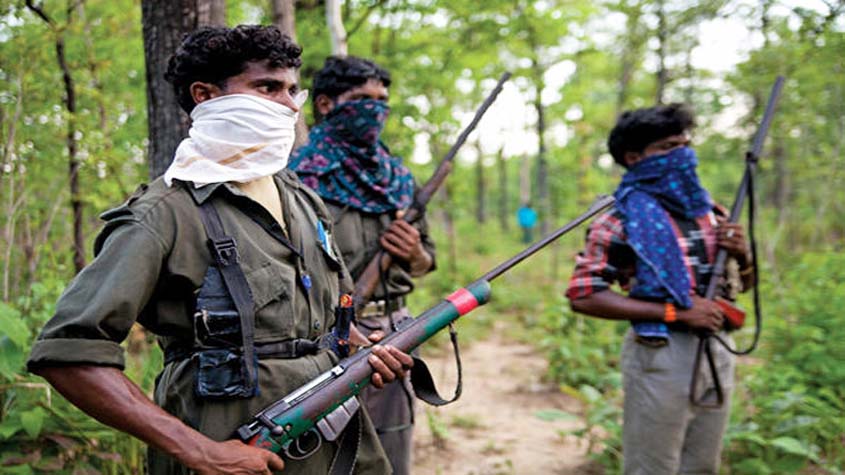In a decisive battle against Maoists on their home turf, the Union Ministry of Home Affairs (MHA) has geared up to flush out armed Maoists from their stronghold in Sukma district of Chhattisgarh within two years, by the time the country goes to polls by the summer of 2019. If Sukma falls by then, it would be a big victory for the Centre which is locked in a vexed jungle war with the Left wing extremists.
The MHA which was alarmed by a spate of killings of Central Reserve Police Force (CRPF) personnel in the past few months in Sukma district is apprehensive that the killings will go up in the coming months, unless some decisive steps were taken. The aim is to see that there are no more killings of paramilitary forces or civilians in Sukma in the run-up to next general elections two years away.
A decision to evict the armed guerillas of Maoists from the forests of Sukma district was taken at a high-level meeting chaired by Union Home Minister Rajnath Singh in Delhi on 8 May. Several chief ministers, home ministers and director generals of police representing 10 Maoist-affected states were present at the meeting, considered to be very crucial to crush the Maoist violence.
Ending a passive, defensive stance towards Left Wing Extremism (LWE) by the previous UPA regime since 2008, the Narendra Modi-led NDA government, which has observed the trends of violence triggered by the Maoists in the past three years, came to the conclusion that a proactive approach was needed to tackle this issue, senior police officials in Hyderabad who are in the know of things told The Sunday Guardian.
Unlike the UPA regime, the present NDA government views LWE as a threat to the internal security of the country.
Today, Sukma occupies the first place among 35 worst-hit districts in the country as a large number of deaths of CRPF and other police forces are happening from here. Sukma is most backward both in terms of economic conditions of the local tribal population as well as road connectivity.
If the average total killing of civilians and paramilitary forces in the country are around 350 per year in the past three years, around 90% of them are from Sukma and its surrounding areas, according to a senior officer from Greyhounds which exclusively deals with Maoist insurgency. In the past two months, Sukma accounted for 35 deaths of CRPF personnel.
The uniqueness of Sukma, which was carved out of previous Bastar district when it was part of Madhya Pradesh, is that it is like a junction for five states—Chhattisgarh, Maharashtra, Telangana, Andhra Pradesh and Orissa. As Sukma has thick forests and poor road connections, the Maoists use this area as safe haven to move around in either direction.
Another interesting feature of the Maoist activity in Sukma is that though a majority of lower rung cadre is local tribal youth, most of the top level leaders are from Telangana or Andhra Pradesh. Till now, police officials from the combined AP used to tip off their counterparts in Chhattisgarh on the movements of Naxalites, but there was no coordinated effect at the national level.
A significant aspect of the latest aggressive approach towards Maoists is that it is being fashioned on the experience and expertise of the Telangana police which has succeeded in ensuring zero deaths due to Maoist violence in the state in the past three years. All other affected states had witnessed at least some killings at the hands of Maoists.
A comprehensive 10-page note submitted by Telangana DGP Anurag Sharma at the meeting was widely circulated among the participants. Rajnath Singh, too, lauded the efforts of Telangana and even Andhra Pradesh police in curbing Maoist violence over the years. He specifically appreciated their levels of intelligence gathering on Maoists.
Maoists suffered a major setback in the combined AP since the breakdown of their talks with the Y.S. Rajasekhara Reddy-led Congress government in 2004. Once the top leaders of Maoists went back to forests to restart their armed activities, the police launched a massive hunt for their leaders and eliminated many of the cadre in a series of encounters.
In this offensive, the Maoists have lost their long held stronghold in Nallamala forest around Srisailam reservoir on Krishna River. All of Nallamala forest zone came as a blow to AP Maoist leaders who had to shift their base to Chhattisgarh and Orissa. The all-out war against Maoists preceded by peace talks is noted by the MHA, the sources said.
The “SAMADHAN’ offensive chalked out by the MHA is a combination of strategies adopted by united AP police against Maoists. Effective intelligence, deployment of more forces, use of modern weapons, development of good roads and weaning away of local tribal youth from the influence of Maoists, are the main aspects of AP cops’ strategy.
SAMADHAN stands for Smart leadership, Aggressive strategy, Motivation and training, Actionable intelligence, Dashboard based KPIs (Key Performance Indicators) and KRAs (Key Result Areas), Harnessing technology, Action plan for each theatre and No access to financing, and is expected to come along with additional financial allocation to the affected states.
The Centre has also alerted Telangana, AP and Orissa on possible migration of Maoist cadre into their areas if the paramilitary forces build up pressure on them in Sukma. “Mission Sukma, as announced by the Union Home Minister, is precisely aimed at freeing the district of Maoists. But, the armed guerillas can move in either direction,” said a senior officer in Hyderabad.
As cops in Telangana and AP are on high vigil along their borders, the extremists might look towards either Jharkhand or Orissa. The southern parts of Orissa, especially Malkangiri area, are severely impacted by Maoist presence. However, the Centre is confident that the Reds might not secure support of local people outside Sukma.

